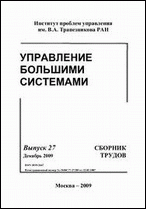|
This article is cited in 1 scientific paper (total in 1 paper)
Control in Medicine, Biology, and Ecology
Aggression in the animats world, or about some mechanisms for aggressive behavior control in group robotics
I. Karpovaab, V. Karpovbc
a National Research University Higher School of Economics, Moscow
b National Research Centre "Kurchatov Institute", Moscow
c Moscow Institute of Physics and Technology
Abstract:
Some possible ways of implementing aggression as one of the mechanisms for the social behavior formation in robots groups are discussed in this work. Aggression is considered as a way to resolve conflicts over resources. The features of the aggressive behavior of eusocial insects (ants) are used as a basic model. A reactive model of behavior was proposed. The aggressive component is integrated into the demand-emotional architecture of the animat's control system, which is presented as a hybrid neuroproduction system. Also, the question of using an aggressive component at the phenomenological level of behavior management. Imitation modeling experiments were carried out on the example of realization of domination in a group. The issue of determining the basic mechanisms for feed areas distribution, which is a part of the foraging task, is also considered. It is shown that such mechanisms are domination (as the result of aggressive actions) and the animats memory. The simulation results confirm that the addition of the "aggressiveness" parameter to the control system provides a variety of animats behavior taking into account the environment state. The proposed aggressive behavior model does not depend on the solved problem, and allows you to manage the group in natural form.
Keywords:
group robotics, social behavior models, aggressive behavior, emotion control system, foraging task.
Received: June 22, 2018
Published: November 30, 2018
Citation:
I. Karpova, V. Karpov, “Aggression in the animats world, or about some mechanisms for aggressive behavior control in group robotics”, UBS, 76 (2018), 173–218
Linking options:
https://www.mathnet.ru/eng/ubs978 https://www.mathnet.ru/eng/ubs/v76/p173
|

|




 Contact us:
Contact us: Terms of Use
Terms of Use
 Registration to the website
Registration to the website Logotypes
Logotypes








 Citation in format
Citation in format 
